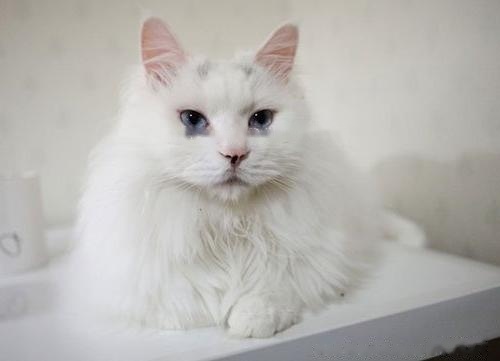The Angora is one of the oldest breeds, originating from Turkey. In the 16th century, it was introduced into Europe, into Italy and France, and then into the United Kingdom. It was mainly distributed in France and the United Kingdom. It was the most popular long-haired breed at that time.

Morphological characteristics of Turkish Angora
The Angora cat is slender and has a more undulating back Large, with tall and slender limbs, long and pointed head, and large ears. The whole body is covered with filamentous long hair, which can be divided into red, brown, black and white. It is generally considered that white is an authentic Angora purebred cat. Angora cats are quite agile and independent. The eyes are mostly blue, amber, golden yellow, mandarin duck eyes (gold and silver), the face is V-shaped, and the ears are pointed at the ends, but slightly wider at the bottom. Body and limbs are slender. Angora cats are gentle but very active.
Angora cats have excellent daytime and night vision. In bright places, Angora cats will shrink their pupils as narrow as a line to reduce damage to the retina, but it will limit the breadth of the field of vision . The Angora cat has a blue-green fluorescent-like film on the back of the omentum, which can increase the vision in the dark. In the flash, the Angora cat's eyes can show a variety of colors. Like most carnivores, their eyes face straight ahead, giving them a wide field of vision. Angora cats have poor identification of the three primary colors.
If Angora cats have only low light here, they use whiskers to improve mobility and perception. The beard can feel the very weak wind, so that it can identify where the obstacle is without being able to see it. The circle formed by the tip of the beard and the ears is exactly the smallest range that the body can pass through the obstacle, so it can be used in the dark night. Quickly determine whether the terrain can pass through.
Turkish AngoraFeeding
Angora cats are very clean, for example they lick their fur from time to time. Their saliva acts as a powerful cleaner, but this saliva can sensitize humans. Angora cats may sometimes spit out hairballs due to the accumulation of hairs in the stomach when swallowed during licking. Angora cats still maintain the nocturnal habit of carnivores, and many activities (such as mouse hunting, courtship and mating) are often carried out at night. Angora cats are most active at dawn or evening, and spend most of the day resting or sleeping lazily. The daily sleep time is 12 to 16 hours, with an average of 13 to 14 hours, but some Angora cats sleep for up to 20 hours.
Feed cats with balanced nutrition cat food to make them healthy and lively; clean cat food bowls in time and place them separately; bath cats in time to keep them clean; give cats vaccinations in time to enhance their resistance The ability to get sick; clean up the cat's feces in a timely manner so as not to affect others and the environment; if the cat is sick, take the cat to the veterinary clinic in time.
![[Dog Training 5] The training method of pet dog dining etiquette](/static/img/12192/12192_1.jpg)




